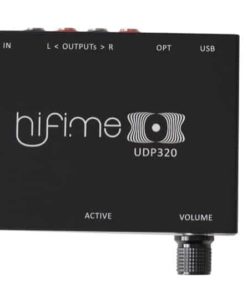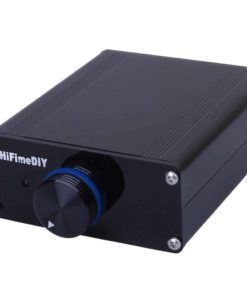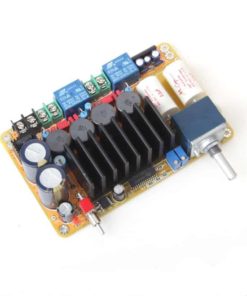Hifime DX200 SPDIF and analog Tripath amplifier 2X150W Jantzen Caps
USD99.00
Out of stock, can be preordered
Notify me when this product is in stock
Tripath amplifiers
Tripath class-T amplifiers are known for their great smooth sound, often compared to that of a tube amplifier. The Tripath company filed a patent in 1996 however the company soon went out of business. Thankfully there are still chips available so we can produce these wonderful sounding Tripath amps.
The DX200
The DX200 is a Tripath amplifier based on the TK2050 chipset, as used in our T1, T2, T3 and T4 amplifiers. It uses the Tripath TC2001 controller together with STMicroelectronics STA516BE output stage chip in BTL mode. The Tripath amplifiers, and especially TK2050 is known for a smooth sound signature, reminiscent of that of a tube amp but with a deep black background. Our bare PCB DIY amps have been very popular because of this, so we are now happy to offer the encased DX200 to a wider audience.
This is a class D amplifier, sometimes referred to as Class-T (for Tripath). The analog signal goes directly to the TC2001 controller, while the SPDIF signal goes to a Sabre ES9023 DAC chip on the way to the controller.The Tripath controller converts the analog signal to PWM signal that is amplified by the output stage chip. The design is very simple, which is responsible for the clear audio quality.
Compact size
This amp is smaller than it looks in the photos! Just 12 cm wide, 9.5 cm deep and 3.5 cm high!
Usage
The DX200 has a minimalist design and functions. There is a single 3.5 mm connector used for either an analog signal or a digital SPDIF/optical signal. The volume control on the front obviously controls volume and power is supplied from any suitable power supply in the range of 36V to 56V. When using 4 ohm speakers the max voltage is 48V. The minimum voltage is 36V, as the relays will not turn on if the supply voltage is lower. We recommend using 48V for all speakers.
Power supply (not included!)
The DX200 needs an external power supply. We recommend the Meanwell GST280A. Alternatively the SMPS300RS 48V 230V or 115V if you don’t mind a DIY bare PCB solution. The power supply connector is the higher current 5.5/2.5 plug, center pin positive. We have a cable available for DIY builds (the Meanwell has this plug already).
Inputs
Analog
- Analog stereo through 3.5mm mini jack plug
SPDIF (optical):
- Accept all sample rates up to 192kHz and 24bit
- 3.5mm optical connector (shared with analog input)
The SPDIF input is converted to analog using ES9023 DAC chip soldered on the PCB. This assures a minimal signal path of the analog audio signal on it’s way to the Tripath TC2001 controller.
Outputs
- 2x150W to 4 ohm@38V
- 2x120W to 8 ohm@48V
- 2x160W to 8 ohm@56V
Speaker outputs use banana style connectors. It is very important that you avoid shorting the output (connecting the + and – together) as that might damage the amplifier. The two negative outputs can not be connected together, as they are not common ground.
Other Specs
- Jantzen Cross Cap
- Speaker protection relay, preventing “pop”sound during power on/off
- Analog input impedance: 20K
- Input sensitivity for full power: 1.5V rms
- Gain: 25x
- Size:115x95x34mm. (excluding volume control 17mm)
- Weight: 450g
model: DX200
| Weight | 0.48000000 kg |
|---|
2 reviews for Hifime DX200 SPDIF and analog Tripath amplifier 2X150W Jantzen Caps
Add a review Cancel reply
Related products
Amplifiers
Amplifiers
Amplifiers
Amplifiers

































Herman –
As a sound engineer, in my opinion the DX200 sounds phenomenal, especially for the money. Clear, uncolored amplification. I have a top notch JK Acoustics preamp in front of it and it sings. More detail than in my old high end Dual amp for sure. I have a powered sub with it that I use when playing electronic music and it’s pure pleasure to listen to. I am really glad I took the leap with Hifime. This combination took my home amp to a much higher level.
Tim –
It’s a powerful amp and drives speakers well but in my experience is very susceptible to ground loop noise. It can’t be turned up past halfway with a USB audio interface connected and can’t be used connected to a sub at all. If your use case doesn’t involve these, it might be suitable, but for me had to be replaced with a Topping PA5 which is a lot more expensive, but works a lot better.